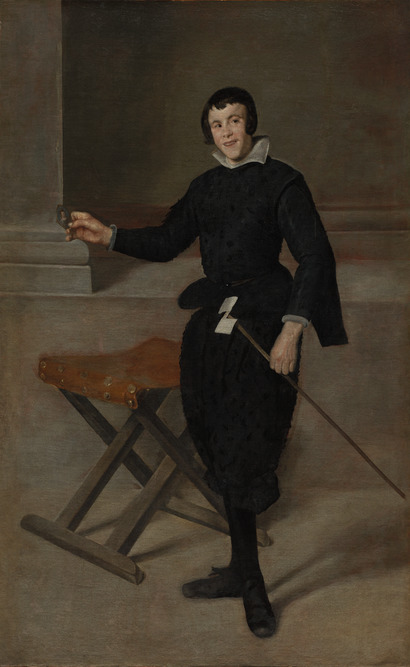The Jester Calabacillas (Cleveland) facts for kids
Quick facts for kids Portrait of the Jester Calabazas |
|
|---|---|
 |
|
| Artist | Diego Velázquez |
| Year | 1630s |
| Medium | oil paint, canvas |
| Dimensions | 175 cm (69 in) × 106 cm (42 in) |
| Location | Cleveland Museum of Art, Doughty House |
| Collection | Cook collection |
The Jester Calabacillas (which means El bufón Calabacillas in Spanish) is a famous painting by the Spanish artist Diego Velázquez. He painted it between 1626 and 1632. Today, you can see this oil on canvas artwork at the Cleveland Museum of Art.
Experts believe Velázquez painted this work because its style looks very similar to his other paintings. For example, the way faces are painted in this work is like the face of Bacchus in his painting The Triumph of Bacchus. The person in the painting is thought to be a jester named Juan Calebasse. A jester was a special entertainer, often a comedian, who worked for kings or nobles. Velázquez also painted Juan Calebasse in another work, which is now in Madrid. There was also a third painting of him, now lost, that was called "calebasses in a turban."
History of the Painting
This painting likely started its journey at the Buen Retiro Palace in Spain. This was a large royal palace. In 1808, during the French occupation of Spain, the painting was taken.
Changing Owners
Over the years, The Jester Calabacillas moved through many hands.
- In 1866, it was shown at a special art show in Paris. At that time, the Duke of Persigny owned it.
- Later, it was sold at an auction at Christie's in London in 1965.
- It was bought for a large sum of money, 170,000 guineas.
- The Cleveland Museum of Art became its proud owner later that same year.
See also
- List of works by Diego Velázquez
 In Spanish: El bufón Calabacillas (1626-1633) para niños
In Spanish: El bufón Calabacillas (1626-1633) para niños

